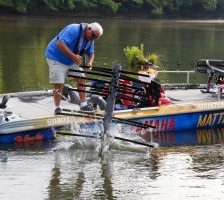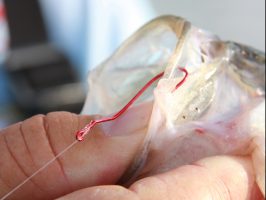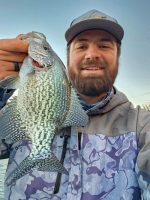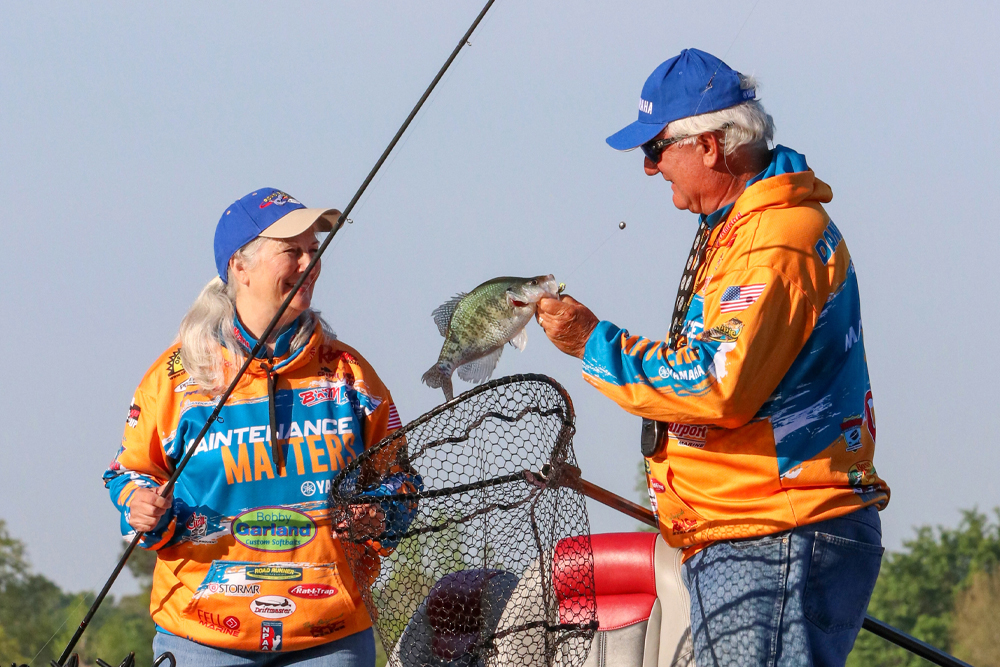The Crappie Mates Team of Dan & Sue Dannenmueller land a crappie in a creek
off the Alabama River. Crappie Dan says September crappie will become more
active each day as the water cools. (Photo: Tim Huffman)
Mastering River Crappie: Tips from the Pros
by Tim Huffman
River fishing is its own beast—alive, restless, and ever-changing. A river can be calm and predictable one day, then fickle and moody the next. Few know that better than river veteran and crappie pro, Dan Dannenmueller, who has spent years learning how to read a river’s moods and coax fish from its shifting waters.
September on the River
“Southern rivers and northern ones run on completely different schedules,” Dannenmueller says with the easy confidence of a man who’s been there and done it—many times over. “Up north, the water cools a month or two ahead of the south. But down south, on the Alabama River, September crappie are still hanging on ledges in 14 to 20 feet of water. It’s the tail end of the dog days. Those cooler nights are just starting to nibble at water temps, and the fish know it. They feed more, they start building eggs—they’re waking up.”

He says the key is shad. Wherever the baitfish go, crappie follow, often settling into brushpiles, laydowns, or other deep cover. Current is another player in the game. The Alabama River always has some, but when the generators kick in, that current stiffens and the fish adjust.
“As the water cools, crappie will slide along with the shad. One day they might be piled on a laydown; the next you’re running upriver or downriver hunting them. You just move from one piece of cover to another until you find them.”
And don’t overlook oxbows and feeder creeks. If they’ve got decent depth and shade, they can hold fish year-round.
“The creeks rise and fall just like the main river,” he says. “Conditions can change in a hurry.”
Working the Current
Capt. Josh Antwine is a professional guide on the Tennessee River near Chattanooga, Tenn. Like Dannenmueller, he well understands the how river crappie work. He specializes in fishing the tailwater area downstream from Chickamauga Dam – a section of the Tennessee River that almost always has considerable current flow.
“From mid-November through January, which is typically our rainy season, we’ll have excellent crappie fishing below these dams,” said Capt. Antwine. “It’s all about the current.”
Capt. Antwine says big schools of threadfin and gizzard shad are attracted to that moving water. And the crappies set up in predictable calm water spots to ambush those roaming baitfish.
“I’m always looking for a place where those crappie can escape the current,” Capt. Antwine said. “Eddies and current seams are good places. I look for something blocking the current, like a rock jetty, a mooring buoy, a brush pile, big rocks—any slack water off the main current where those crappie can stack up.”

He adds that when conditions get right, crappie are easy to find.
“With it being a current-based fishery, the crappies below Chickamauga Dam are pretty easy to pattern,” Capt. Antwine said. “They’ll go to the same places every year. It’s not like I have to go out and relocate them every year.”
Antwine likes to cast Bobby Garland plastic baits on jig heads ranging in weight from 1/8th of an ounce all the way down to 1/64th.
The Right Technique
Dannenmueller has plenty of tricks for river crappie, but he says the most popular these days is jigging with forward-facing sonar (FFS). Early in September, with summer patterns still in play, he’s dropping baits into cover along drop-offs—especially laydowns, which give fish a good break from the current.
He favors a double-hook rig when working cover. Two baits mean two depth zones, and sometimes two fish.
“The first crappie you hook can actually fire up another one,” he explains.
When the river’s falling, things get interesting.
“That moving water pulls shad off the flats and funnels them into deeper edges. The crappie are there, waiting. But it’s harder fishing because they scatter. You’ve got to search. Out of a hundred stumps, maybe only one will hold a handful of fish.”
The Gear and the Bite
Crappie Dan’s go-to stick is the 13.5-foot Diamond Series B’n’M pole—long enough to reach fish, light enough to work all day. For ultra-skittish crappie, he’ll go even longer, swapping to a 16- or 18-foot Black Diamond.

September calls for a double-hook rig baited with minnows or a jig/minnow combo for working the edges of cover. But when the fish are buried deep in thick stuff, he downsizes to a single 1/32-ounce jig, like a Bobby Garland Itty Bit, which matches the small shad from the late hatch. Sometimes he’ll pinch on a worm-weight six inches above the jig to punch it down fast.
Searching is half the game. Early morning crappie often hang high in the cover before sliding deeper as the sun climbs. Shade is gold. In current, they’ll tuck on the backside of structure. Cooling water makes them friskier, but every change in the river shifts the puzzle.
“A steady current is perfect—they feed and stay put. Fast current pushes them to eddies, but they’ll still bite. No current is the worst; they scatter and you’re in for a hunt. Throw in rising or falling water, muddy runoff, boat traffic—it’s a lot of moving pieces. But don’t let that stop you. River crappie are always worth chasing.”
Dannenmueller’s Year-Round River Crappie Guide (Southern Rivers)
- September – Active bite on 14–20 ft ledges with cover.
- October – Fish are roaming, chasing shad, suspending over cover.
- November – Still feeding, shifting toward deeper winter spots. Find shallow 60°F water and you’ll find crappie.
- December – Less aggressive but still catchable.
- January – Slow bites in deep holes.
- February – Winter fishing, with early black crappie spawning in shallow creeks.
- March – Prime time: 60–65°F water. Black crappie spawn, whites start soon after.
- April – Late spawners still active.
- May – Post-spawn fish suspend on flats; all techniques work.
- June – Bite slows; fish slide into summer patterns.
- July–August – Deep water, slow presentations, stick with any group you find.
CrappieNOW senior writer and Fresh Water Fishing Hall of Fame member, Tim Huffman, has several books, including his newest, Papermouth, Modern Fishing Techniques, available in Kindle or paperback at Amazon, or link from his website, www.monstercrappie.com


